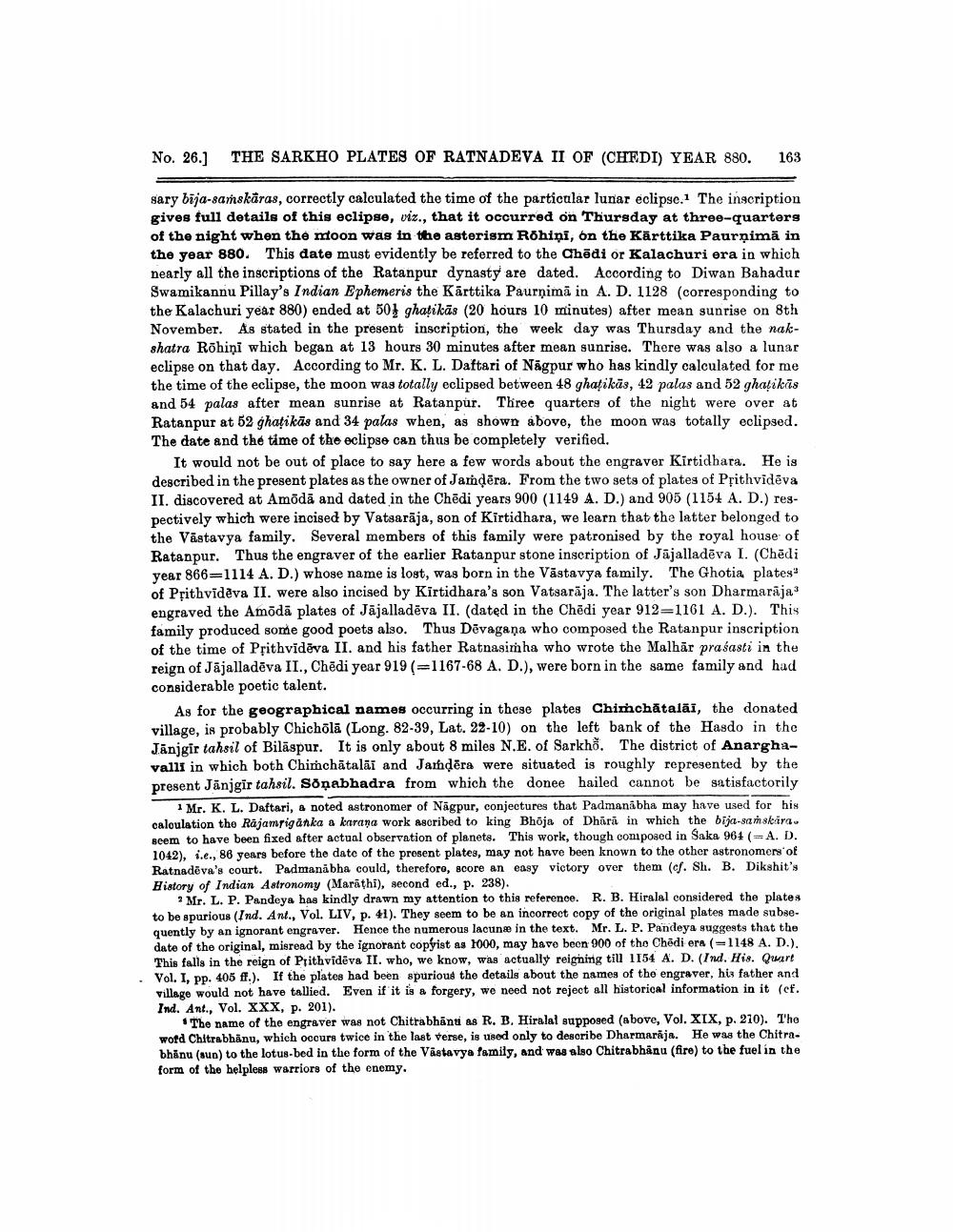________________
No. 26.)
THE SARKHO PLATES OF RATNADEVA II OF (CHEDI) YEAR 880.
163
sary bija-saṁskāras, correctly calculated the time of the particular lunar eclipse. The inscription gives full details of this eclipse, viz., that it occurred on Thursday at three-quarters of the night when the moon was in the asterism Rohini, on the Kārttika Paurạimă in the year 880. This date must evidently be referred to the Chēdi or Kalachuri era in which nearly all the inscriptions of the Ratanpur dynasty are dated. According to Diwan Bahadur Swamikannu Pillay's Indian Ephemeris the Kārttika Paurnima in A. D. 1128 (corresponding to the Kalachuri year 880) ended at 504 ghatikās (20 hours 10 minutes) after mean sunrise on 8th November. As stated in the present inscription, the week day was Thursday and the nakshatra Rõhiņi which began at 13 hours 30 minutes after mean sunrise. There was also a lunar eclipse on that day. According to Mr. K. L. Daftari of Nagpur who has kindly calculated for me the time of the eclipse, the moon was totally eclipsed between 48 ghatikās, 42 palas and 52 ghatikās and 54 palas after mean sunrise at Ratanpur. Three quarters of the night were over at Ratanpur at 52 ghatikās and 34 palas when, as shown above, the moon was totally eclipsed. The date and the time of the eclipse can thus be completely verified.
It would not be out of place to say here a few words about the engraver Kirtidhara. He is described in the present plates as the owner of Jamdēra. From the two sets of plates of Přithvidēva II. discovered at Amõdā and dated in the Chēdi years 900 (1149 A. D.) and 905 (1154 A. D.) respectively which were incised by Vatsarāja, son of Kirtidhara, we learn that the latter belonged to the Vāstavya family. Several members of this family were patronised by the royal house of Ratanpur. Thus the engraver of the earlier Ratanpur stone inscription of Jājalladēva I. (Chēdi year 866=1114 A. D.) whose name is lost, was born in the Vástavya family. The Ghotia plates of Prithvideva II. were also incised by Kirtidhara's son Vatsarāja. The latter's son Dharmarāja engraved the Amõdā plates of Jājalladēva II. (dated in the Chēdi year 912-1161 A. D.). This family produced some good poets also. Thus Dēvagana who composed the Ratanpur inscription of the time of Prithvidova II, and his father Ratnasimha who wrote the Malhar prasasti in the reign of Jājalladēva II., Chēdi year 919 (=1167-68 A. D.), were born in the same family and had considerable poetic talent.
As for the geographical names occurring in these plates Chimchătalai, the donated village, is probably Chichõlā (Long. 82-39, Lat. 22-10) on the left bank of the Hasdo in the Janjgir tahsil of Bilaspur. It is only about 8 miles N.E. of Sarkhổ. The district of Anarghavalli in which both Chimchātalai and Jamdēra were situated is roughly represented by the present Jānjgir tahsil. Soñabhadra from which the donee hailed cannot be satisfactorily
Mr. K. L. Daftari, a noted astronomer of Nagpur, conjectures that Padmanabha may have used for his caloulation the Rajamriganka a karana work ascribed to king Bhoja of Dhārā in which the bija-szi skära. seem to have been fixed after actual observation of planets. This work, though composed in Saka 964 (A. D. 1042), i.e., 86 years before the date of the present plates, may not have been known to the other astronomers of Ratnadēva's court. Padmanabha could, thereforo, score an easy victory over them (cf. Sh. B. Dikshit's History of Indian Astronomy (Marathi), second ed., p. 238).
Mr. L. P. Pandeya has kindly drawn my attention to this reference. R. B. Hiralal considered the plates to be spurious (Ind. Ant., Vol. LIV, p. 41). They seem to be an incorrect copy of the original plates made subsequently by an ignorant engraver. Hence the numerous lacune in the text. Mr. L. P. Pandeya suggests that the date of the original, misread by the ignorant copyist as 1000, may have been 900 of the Chēdi era (=1148 A. D.). This falls in the reign of Prithvidēva II. who, we know, was actually reigning till 1154 A. D. (Ind. His. Quirt Vol. I, pp. 405 ff.). If the plates had been spurious the details about the names of the engraver, his father and village would not have tallied. Even if it is a forgery, we need not reject all historical information in it (ef. Ind. Ant., Vol. XXX, p. 201).
The name of the engraver was not Chitrabhānu as R. B. Hiralal supposed (above, Vol. XIX, p. 210). The word Chitrabhanu, which occurs twice in the last verse, is used only to describe Dharmarāja. He was the Chitrabhānu (sun) to the lotus-bed in the form of the Vastavya family, and was also Chitrabhånu (fire) to the fuel in the form of the helpless warriors of the enemy.




